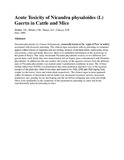Acute Toxicity of Nicandra physaloides (L) Gaertn in Cattle and Mice

View/
Date
2009Author
Muthee, J.K.
Mbaria, J.M.
Thaiya, A.G.
Gakuya, D.W.
Type
ArticleLanguage
enMetadata
Show full item recordAbstract
Nicandra physaloides (L) Gaertn (Solanaceae), commonly
known as the ‘apple of Peru’ is widely associated with
livestock poisoning. The clinical signs associated with its
poisoning in ruminants appear within 6 hours of ingestion
and are circling, tremors of the hind limbs, tachycardia,
bloat, convulsions, coma and death. However, there is
no published information on the toxicology of this plant
in Kenya. This study documents Nicandra physaloides
toxicity in two different zero-grazed dairy cattle herds
that were inadvertently fed on Napier grass contaminated
with Nicandra physaloides. In addition to the case
studies, the toxicity of the aqueous extracts from the different
parts of Nicandra physaloides was studied under
experimental conditions in mice. The 24 hour median
lethal dose (LD50) was determined after intra-peritoneal
injection (i.p.) of the aqueous extracts of the plant into
white Swiss mice and found to be 1820, 2580 and 3620
mg/kg body weight for the leaves, fruits and whole plant
respectively. The clinical signs in mice appeared within
30 minutes of inoculation and included coat, decreased
locomotor activity, increased respiratory rate, gasping for
air and leaping into the air before collapsing into coma
and death. There were similarities in the symptoms of
the spontaneous poisoning in cattle and in the experimentally
induced poisoning in mice.
Citation
The Kenya Veterinarian Vol 33 (1) 2009Publisher
Department of clinical studies
